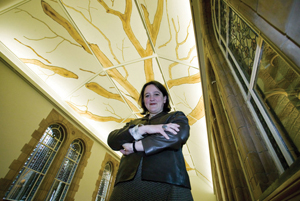Bergit Arends shows how artists can help museums to see themselves in a new light.

The Natural History Museum in London has been working with contemporary artists for a number of years, through various models. This dialogue between the museum and artists is predicated on artists being able to engage with science, scientific research and the history of the Museum’s collections and displays. It is through this that we hope to provoke and challenge the museum’s understanding of itself. Out of this dialogue comes the ability to commission works that challenge the public’s understanding of topical questions relating to the museum’s science communication agenda, which intersects with our place as a research organisation and our role within society.
One of the museum’s major temporary exhibition spaces, the Jerwood Gallery, has been used to display art exhibitions that have been specially commissioned. ‘Systema Metropolis’ in 2007 was a new commission by artist Mark Dion. The exhibition display grew out of a collaboration between the artist and museum scientists, exploring the everyday environs of London through fieldwork and celebrating the work of eighteenth century Swedish scientist, Carl Linnaeus. The exhibition presented a microcosm of the Museum, its display and the work that goes on behind the scenes. This year the Museum opened its first permanent art installation. Inserted into the fabric of the nineteenth century listed building, the work, ‘TREE’ by Tania Kovats, was specially commissioned to mark the bicentenary of the birth of Charles Darwin. Later this year, we will open a new group exhibition for the Jerwood Gallery, ‘After Darwin: Contemporary Expressions’. The point of inspiration for this exhibition is Darwin’s late publication ‘The Expression of the Emotions in Man and Animals’ which served as a starting point to commission artists and writers to respond to this subject. It was also a new model which we used to experiment with how to create an innovative and imaginative engagement with science from a cultural perspective. Artists who responded include Diana Thater, who was sent to Cameroon on behalf of the museum to film gorillas in a wildlife sanctuary, Jeremy Deller and Matthew Killip in collaboration with psychologist Richard Wiseman, and writers Mark Haddon and Ruth Padel.
A range of artists are always working in the museum, often enabled by grants to undertake their research with us. Collaborations have included working with the Arts Catalyst and other institutions. The museum’s science and library collections are free to access and can be used by anybody. Often longer-term projects develop with artists out of this first interest. The museum’s arts programme offers the opportunity for artists to research and develop new work, to experiment with new methodologies and to create site-specific new works. It’s encouraging that we can offer artists the possibility for research and new works that are away from the vagaries of an inflated art market. We are keen to support cultural and artistic enquiries that create works with a wide variety of associations, iconographic innovation, that value the imagination, and are intellectually robust. Beyond engrained structures of scientific working processes and those of the art world, artists are invited to engage with pressing environmental issues, the crisis of biodiversity, the history of collections, the perception of science within culture, making the Natural History Museum a place of consequence. n
Bergit Arends is the Curator of Contemporary Arts at the Natural History Museum in London.
w: http://www.nhm.ac.uk



